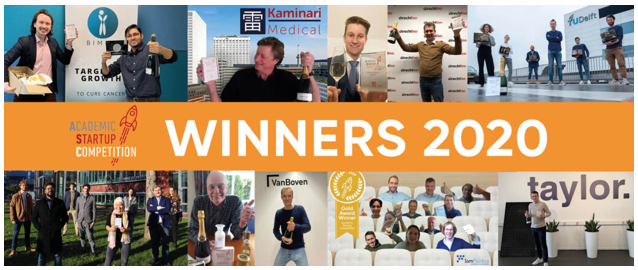
Three spin-offs from Eindhoven University of Technology (TU/e) – Lusoco, NC Biomatrix, and Taylor- are among those who have won the title ‘Best Academic Start-up of 2020‘. There are a total of ten winners at the Academic Startup Competition 2020. The others are Bimini Biotech, DeNoize, Digi.Bio, IamFluidics, Kaminari Medical, uCrowds and VanBoven.
The Academic Startup Competition is an initiative of the Association of Universities (VSNU), the Dutch Federation of University Medical Centers (NFU), Netherlands Academy of Technology and Innovation (AcTI) and Techleap. The competition is sponsored by the Ministry of Economic Affairs and Climate. The organizers put valorization and academic spinoffs within the universities in the spotlight with this competition.
The winners were chosen based on their value proposition, the innovative character of their technology, the potential of their business and revenue model, and the make-up of the start-up team.
Professionalizing the exchange of knowledge
The ambassador of Teachleap.nl, Constantijn van Oranje, states that the winners and this competition show that the Dutch academic start-up ecosystem is full of energy and highly inventive. “The time is now ripe to further professionalize the exchange of expertise in the Netherlands. Knowledge alone is not enough. Ultimately, it is the market that determines whether a company is successful or not. Not the technology. That’s why you also need entrepreneurship,” says Van Oranje in the press release of the Academic Startup Competition.
The winning start-ups will be participating in an intensive incubation program to boost their development opportunities. They will also be introduced to a network of entrepreneurs, investors and businesses. In addition, they will have access to a coaching program with dedicated mentors.
Harvesting energy with glass
“Lusoco produces glass that harvests energy during the day and emits light at night. By printing glass or plastic with highly fluorescent ink developed by them, the light that falls on the printed surface is emitted again in such a way that it shines out from the sides of the window pane. Solar cells on the sides of the glass convert this emitted sunlight into energy.
Higher yield with solar panels
Taylor develops and supplies microelectronics for the solar cell industry. Using Taylor’s product, photovoltaic equipment is safer and faster to design, build, and maintain on a commercial scale, while providing higher yields.
Lower back pain treatment
NC Biomatrix focuses on what is known as degenerative discopathy, the most common cause of back pain. The product of NC Biomatrix is a medical treatment. It can restore the natural biomechanics of the spine and thus relieve lower back pain.
Inhibitor of cancer cell growth
BIMINI Biotech from Leiden develops innovative therapies in oncology by researching on the growth of cancer cells. The lead compounds from BIMINI have shown promising results in the preclinical phase and the company is now committed to bringing the technology into the clinic.
Predicting harvests
The start-up Vanboven, which is based in The Hague, is active in forecasting crop harvests. This makes it possible to match supply and demand perfectly. The result is less waste, short chains and fair prices, according to the founders. Vanboven makes predictions based on drone data, weather data and plant schedules.
Low frequency sounds
In urban environments, many people suffer from noise pollution. Double glass it. But low-frequency sounds, such as the infamous low humming tones, go right through it. The initiators of DeNoize, originally students from the Delft University of Technology, came up with an active noise cancelling kit to counteract this kind of noise.
Bioprocessor
Digi.bio is developing a bioprocessor that links ‘digital microfluidics’ to artificial intelligence. Digi.bio makes it possible to automate repetitive actions in biological research such as pipetting. To achieve this, the company uses the techniques Electrowetting (EWOD) and Digital Microfluidics (DMF). EWOD is the movement of droplets of a very precise size on a substrate using electric fields.
Manipulating liquids
Microfluidics is used to manipulate liquids on a micrometer scale. This enables you to produce minuscule droplets and particles. These form raw materials for medicines, cosmetics and chemical products, for example. IamFluidics from Twente has developed a new method that allows the process to run much faster
More precise imagery of arteries
Kaminari Medical, Kaminari Medical, a spin-off from the Erasmus University in Rotterdam, has developed a new way of intracoronary imaging. Arteries can narrow due to so-called plaques. Kaminari Medical makes it possible to visualize these types of plaques. By combining a laser and a sound pulse (intravascular photo-acoustics), the doctor can literally get an image of both the shape and the content of the plaque, making it easier to treat them with stents and medication.
Follow the crowd
uCrowds from Utrecht has designed simulation software that can simulate the movements of large crowds of people. Based on this, municipalities can, for instance, when organizing large events, see in advance what measures they need to take in order to manage those crowds of people.

